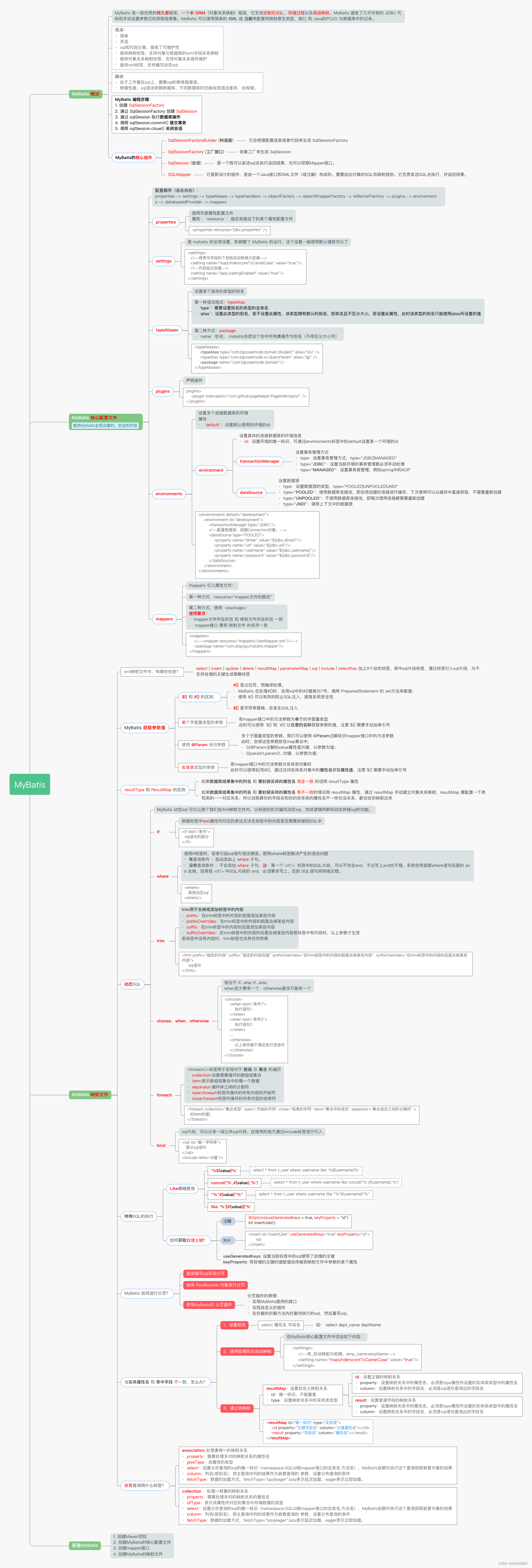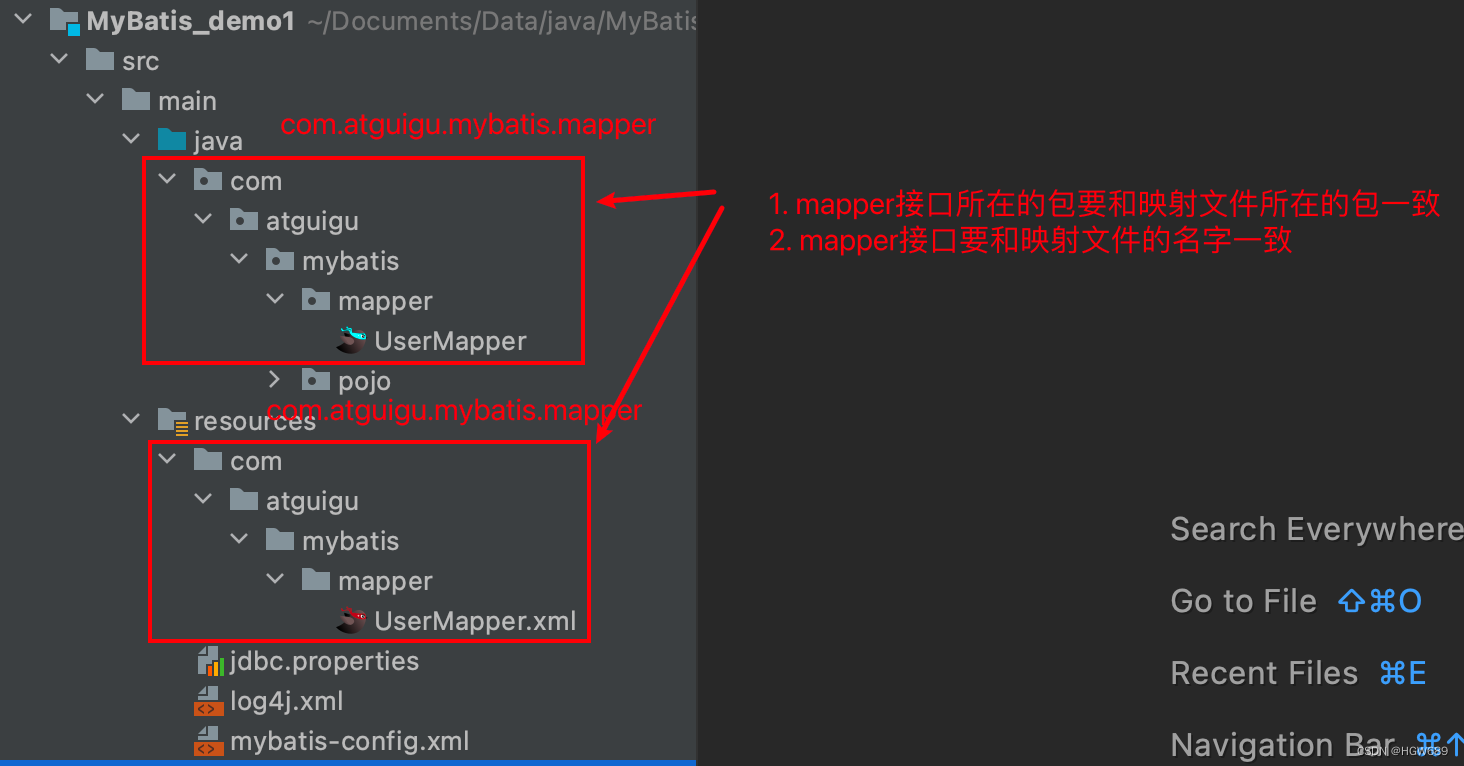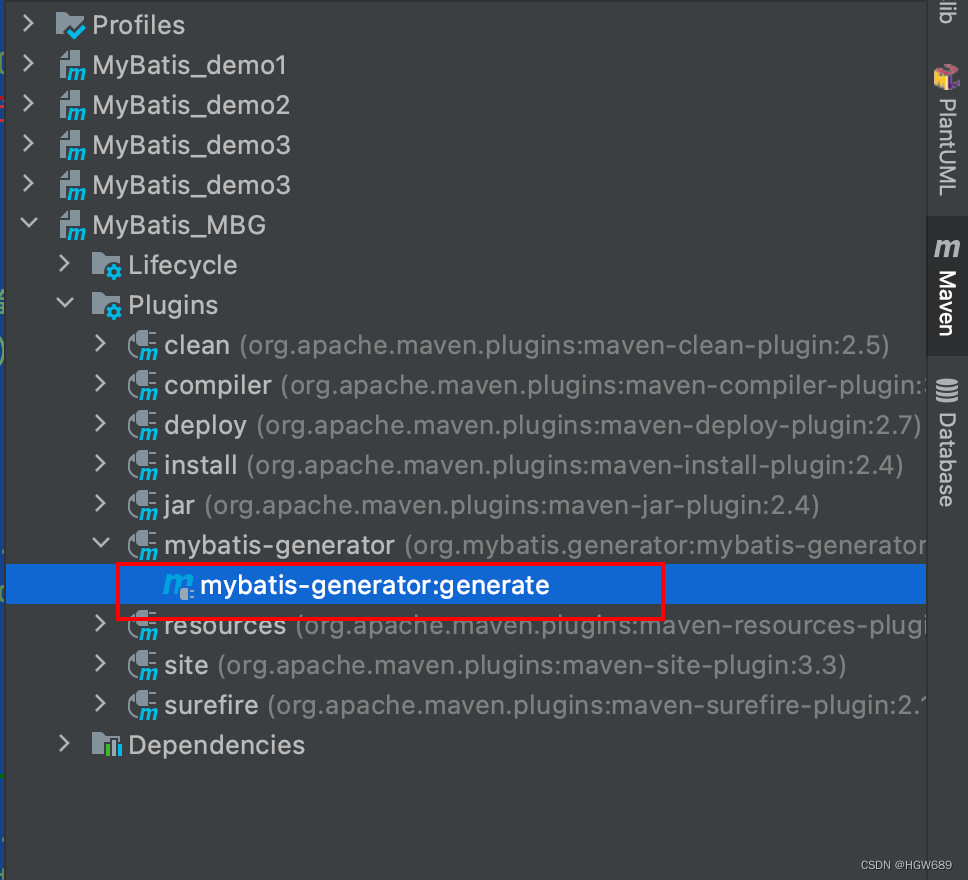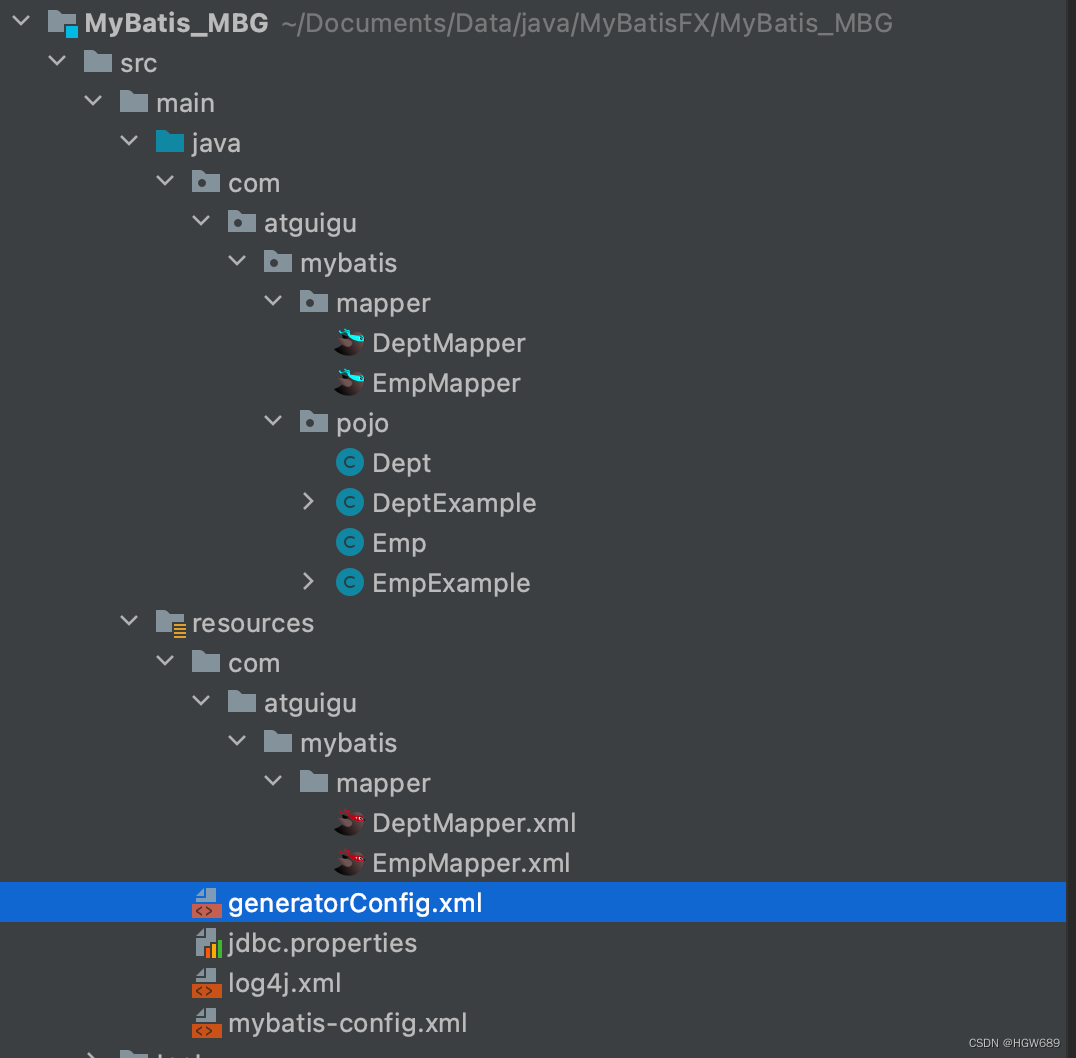首先一波思维导图:


一、搭建MyBatis项目 CRUD
- 创建Maven项目
- 创建MyBatis的核心配置文件
- 创建mapper接口
- 创建MyBatis的映射文件
第一步、创建Maven项目
第一步、创建一个Maven项目
- a> 打包方式:
jar - b> 引入依赖
<?xml version="1.0" encoding="UTF-8"?>
<project xmlns="http://maven.apache.org/POM/4.0.0"
xmlns:xsi="http://www.w3.org/2001/XMLSchema-instance"
xsi:schemaLocation="http://maven.apache.org/POM/4.0.0 http://maven.apache.org/xsd/maven-4.0.0.xsd">
<modelVersion>4.0.0</modelVersion>
<groupId>com.atguigu.mybatis</groupId>
<artifactId>MyBatis_demo1</artifactId>
<version>1.0-SNAPSHOT</version>
<packaging>jar</packaging>
<dependencies>
<!-- mybatis依赖 -->
<dependency>
<groupId>org.mybatis</groupId>
<artifactId>mybatis</artifactId>
<version>3.5.1</version>
</dependency>
<!-- mysql驱动 -->
<dependency>
<groupId>mysql</groupId>
<artifactId>mysql-connector-java</artifactId>
<version>8.0.26</version>
</dependency>
<!--单元测试-->
<dependency>
<groupId>junit</groupId>
<artifactId>junit</artifactId>
<version>4.11</version>
<scope>test</scope>
</dependency>
<!-- lombok -->
<dependency>
<groupId>org.projectlombok</groupId>
<artifactId>lombok</artifactId>
<version>1.18.22</version>
</dependency>
<!-- log4j -->
<dependency>
<groupId>log4j</groupId>
<artifactId>log4j</artifactId>
<version>1.2.17</version>
</dependency>
</dependencies>
</project>
准备好需要的环境:
1、创建PoJO
package com.atguigu.mybatis.pojo;
@Data
@AllArgsConstructor
@NoArgsConstructor
@ToString
public class User {
private Integer id;
private String username;
private String password;
private Integer age;
private String sex;
private String email;
}
2、数据源配置 src/main/resources目录下
jdbc.driver=com.mysql.cj.jdbc.Driver
jdbc.url=jdbc:mysql://localhost:3306/mybatis?useUnicode=true&characterEncoding=utf-8
jdbc.username=root
jdbc.password=hgw6721224
3、日志配置文件 src/main/resources目录下
<?xml version="1.0" encoding="UTF-8" ?>
<!DOCTYPE log4j:configuration SYSTEM "log4j.dtd">
<log4j:configuration xmlns:log4j="http://jakarta.apache.org/log4j/">
<appender name="STDOUT" class="org.apache.log4j.ConsoleAppender">
<param name="Encoding" value="UTF-8" />
<layout class="org.apache.log4j.PatternLayout">
<param name="ConversionPattern" value="%-5p %d{MM-dd HH:mm:ss,SSS} %m (%F:%L) \n" />
</layout>
</appender>
<logger name="java.sql">
<level value="debug" />
</logger>
<logger name="org.apache.ibatis">
<level value="info" />
</logger>
<root>
<level value="debug" />
<appender-ref ref="STDOUT" />
</root>
</log4j:configuration>
**第二步、**创建MyBatis的核心配置文件
习惯上命名为mybatis-config.xml,这个文件名仅仅只是建议,并非强制要求。将来整合Spring
之后,这个配置文件可以省略,所以大家操作时可以直接复制、粘贴。
核心配置文件主要用于配置连接数据库的环境以及MyBatis的全局配置信息
核心配置文件存放的位置是src/main/resources目录下
<?xml version="1.0" encoding="UTF-8" ?>
<!DOCTYPE configuration
PUBLIC "-//mybatis.org//DTD Config 3.0//EN"
"http://mybatis.org/dtd/mybatis-3-config.dtd">
<configuration>
<!--
MyBatis核心配置文件中,标签的顺序:
properties?,settings?,typeAliases?,typeHandlers?,
objectFactory?,objectWrapperFactory?,reflectorFactory?,
plugins?,environments?,databaseIdProvider?,mappers?
-->
<!--引入properties文件-->
<properties resource="jdbc.properties" />
<!--设置类型别名-->
<typeAliases>
<!--
typeAlias:设置某个类型的别名
属性:
type:设置需要设置别名的类型
alias:设置某个类型的别名,若不设置该属性,那么该类型拥有默认的别名,即类名且不区分大小写
-->
<!--<typeAlias type="com.atguigu.mybatis.pojo.User"></typeAlias>-->
<!--以包为单位,将包下所有的类型设置默认的类型别名,即类名且不区分大小写-->
<package name="com.atguigu.mybatis.pojo"/>
</typeAliases>
<!--
environments:配置多个连接数据库的环境
属性:
default:设置默认使用的环境的id
-->
<environments default="development">
<!--
environment:配置某个具体的环境
属性:
id:表示连接数据库的环境的唯一标识,不能重复
-->
<environment id="development">
<!--
transactionManager:设置事务管理方式
属性:
type="JDBC|MANAGED"
JDBC:表示当前环境中,执行SQL时,使用的是JDBC中原生的事务管理方式,事务的提交或回滚需要手动处理
MANAGED:被管理,例如Spring
-->
<transactionManager type="JDBC"/>
<!--
dataSource:配置数据源
属性:
type:设置数据源的类型
type="POOLED|UNPOOLED|JNDI"
POOLED:表示使用数据库连接池缓存数据库连接
UNPOOLED:表示不使用数据库连接池
JNDI:表示使用上下文中的数据源
-->
<dataSource type="POOLED">
<!--设置连接数据库的驱动-->
<property name="driver" value="${jdbc.driver}"/>
<!--设置连接数据库的连接地址-->
<property name="url" value="${jdbc.url}"/>
<!--设置连接数据库的用户名-->
<property name="username" value="${jdbc.username}"/>
<!--设置连接数据库的密码-->
<property name="password" value="${jdbc.password}"/>
</dataSource>
</environment>
<environment id="test">
<transactionManager type="JDBC"/>
<dataSource type="POOLED">
<property name="driver" value="com.mysql.jdbc.Driver"/>
<property name="url" value="jdbc:mysql://localhost:3306/mybatis"/>
<property name="username" value="root"/>
<property name="password" value="123456"/>
</dataSource>
</environment>
</environments>
<!--引入映射文件-->
<mappers>
<!--<mapper resource="mappers/UserMapper.xml"/>-->
<!--
以包为单位引入映射文件
要求:
1、mapper接口所在的包要和映射文件所在的包一致
2、mapper接口要和映射文件的名字一致
-->
<package name="com.atguigu.mybatis.mapper"/>
</mappers>
</configuration>
第三步、创建mapper接口
MyBatis中的mapper接口相当于以前的dao。但是区别在于,mapper仅仅是接口,我们不需要
提供实现类。
package com.atguigu.mybatis.mapper;
import com.atguigu.mybatis.pojo.User;
import java.util.List;
/**
* MyBatis面向接口编程的两个一致:
* 1、映射文件的namespace要和mapper接口的全类名保持一致
* 2、映射文件中SQL语句的id要和mapper接口中的方法名一致
*
* 表--实体类--mapper接口--映射文件
*/
public interface UserMapper {
/**
* 添加用户信息
*/
int insertUser();
/**
* 修改用户信息
*/
void updateUser();
/**
* 删除用户信息
*/
void deleteUser();
/**
* 根据id查询用户信息
*/
User getUserById();
/**
* 查询所有的用户信息
*/
List<User> getAllUser();
}
第四步、创建MyBatis的映射文件
相关概念:ORM(Object Relationship Mapping)对象关系映射。
- 对象:Java的实体类对象
- 关系:关系型数据库
- 映射:二者之间的对应关系
| Java概念 | 数据库概念 |
|---|---|
| 类 | 表 |
| 属性 | 字段/列 |
| 对象 | 记录/行 |
1、映射文件的命名规则:
- 表所对应的实体类的类名+Mapper.xml
例如:表t_user,映射的实体类为User,所对应的映射文件为UserMapper.xml - 因此一个映射文件对应一个实体类,对应一张表的操作
- MyBatis映射文件用于编写SQL,访问以及操作表中的数据
- MyBatis映射文件存放的位置是src/main/resources/mappers目录下
2、MyBatis中可以面向接口操作数据,要保证两个一致:
- mapper接口的全类名 和 映射文件的命名空间(namespace)保持一致
- mapper接口中方法的方法名 和 映射文件中编写SQL的标签的id属性 保持一致
<?xml version="1.0" encoding="UTF-8" ?>
<!DOCTYPE mapper
PUBLIC "-//mybatis.org//DTD Mapper 3.0//EN"
"http://mybatis.org/dtd/mybatis-3-mapper.dtd">
<mapper namespace="com.atguigu.mybatis.mapper.UserMapper">
<!--int insertUser();-->
<insert id="insertUser">
insert into t_user values(2,'admin','123456',23,'男','12345@qq.com')
</insert>
<!--void updateUser();-->
<update id="updateUser">
update t_user set username = '张三' where id = 4
</update>
<!--void deleteUser();-->
<delete id="deleteUser">
delete from t_user where id = 5
</delete>
<!--User getUserById();-->
<!--
查询功能的标签必须设置resultType或resultMap
resultType:设置默认的映射关系
resultMap:设置自定义的映射关系
-->
<select id="getUserById" resultType="com.atguigu.mybatis.pojo.User">
select * from t_user where id = 3
</select>
<!--List<User> getAllUser();-->
<select id="getAllUser" resultType="User">
select * from t_user
</select>
</mapper>
二、核心配置文件详解
2.1、核心配置文件概述
提供MyBatis全局设置的。包含的内容日志、数据源、mapper文件位置。
1、头部约束文件:

<?xml version="1.0" encoding="UTF-8" ?>
<!DOCTYPE configuration
PUBLIC "-//mybatis.org//DTD Config 3.0//EN"
"http://mybatis.org/dtd/mybatis-3-config.dtd">
<configuration>
2、根元素:
==<configuration>==主要包含:
- 定义别名
- 数据源
- Mapper 文件
配置顺序(自左向右):

properties -> settings -> typeAliases -> typeHandlers -> objectFactory -> objectWrapperFactory -> reflectorFactory -> plugins -> environments -> databaseIdProvider -> mappers
2.2、核心配置文件详解
1、properties 属性
使用外部属性配置文件
属性: resource :指定类路径下的某个属性配置文件
<!--引入properties文件-->
<properties resource="jdbc.properties" />
使用步骤:
- 在 resource 目录中,创建 xxx.properties
- 在 xxx.properties 文件中,使用 key=value 的格式定义数据
- 在 MyBatis的核心配置文件,使用
<properties resource="xxx.properties" />标签引用外部属性配置文件 - 在使用值的位置上,使用
${key}获取 key对应的value
2、settings 设置
是 mybatis 的全局设置,影响整个 MyBatis 的运行。这个设置一般使用默认值就可以了
如:
<settings>
<!--将表中字段的下划线自动转换为驼峰-->
<setting name="mapUnderscoreToCamelCase" value="true"/>
<!--开启延迟加载-->
<setting name="lazyLoadingEnabled" value="true"/>
</settings>
3、typeAliases 属性
设置某个具体的类型的别名
- 第一种语法格式:
- typeAlias
type:需要设置别名的类型的全类名alias:- 设置此类型的别名,若不设置此属性,该类型拥有默认的别名,即类名且不区分大小
- 若设置此属性,此时该类型的别名只能使用alias所设置的值
- typeAlias
- 第二种方式:
- package
name:包名, mybatis会把这个包中所有类名作为别名(不用区分大小写)
- package
<typeAliases>
<typeAlias type="com.bjpowernode.domain.Student" alias="stu" />
<typeAlias type="com.bjpowernode.vo.QueryParam" alias="qp" />
<package name="com.bjpowernode.domain"/>
</typeAliases>
?
4、plugins 属性
声明插件
<!--声明插件-->
<plugins>
<plugin interceptor="com.github.pagehelper.PageInterceptor" />
</plugins>
5、environments 属性
environments:设置多个连接数据库的环境
- 属性:
default:设置默认使用的环境的id
- 子标签:
environment:设置具体的连接数据库的环境信息- id:设置环境的唯一标识,可通过environments标签中的default设置某一个环境的id,
- transactionManager:设置事务管理方式
- type:设置事务管理方式,type=“JDBC|MANAGED”
- type=“JDBC”:设置当前环境的事务管理都必须手动处理
- type=“MANAGED”:设置事务被管理,例如spring中的AOP
- dataSource :设置数据源
- type:设置数据源的类型,type=“POOLED|UNPOOLED|JNDI”
- type=“POOLED”:使用数据库连接池,即会将创建的连接进行缓存,下次使用可以从缓存中直接获取,不需要重新创建
- type=“UNPOOLED”:不使用数据库连接池,即每次使用连接都需要重新创建
- type=“JNDI”:调用上下文中的数据源
<environments default="development">
<environment id="development">
<transactionManager type="JDBC"/>
<!--配置数据源:创建Connection对象。-->
<dataSource type="POOLED">
<property name="driver" value="${jdbc.dirver}"/>
<property name="url" value="${jdbc.url}"/>
<property name="username" value="${jdbc.username}"/>
<property name="password" value="${jdbc.password}"/>
</dataSource>
</environment>
</environments>
6、mappers 属性
mappers 引入属性文件:
- 第一种方式,resource=“mapper文件的路径”
- 第二种方式,使用
<package>- 使用要求:
1. mapper文件所在的包 和 映射文件所在的包 一致
2. mapper接口 要和 映射文件 的名字一致
- 使用要求:
<mappers>
<!--<mapper resource="mappers/UserMapper.xml"/>-->
<package name="com.atguigu.mybatis.mapper"/>
</mappers>

三、映射文件
MyBatis获取参数值的两种方式:${}和#{}
-
${}的本质就是字符串拼接,#{}的本质就是占位符赋值
-
${}使用字符串拼接的方式拼接sql,若为字符串类型或日期类型的字段进行赋值时,需要手动加单引号;但是#{}使用占位符赋值的方式拼接sql,此时为字符串类型或日期类型的字段进行赋值时,可以自动添加单引号
3.1、单个字面量类型的参数
单个字面量类型的参数
若mapper接口中的方法参数为单个的字面量类型
此时可以使用 ${}和 #{}以任意的名称获取参数的值,注意${}需要手动加单引号
@Test
public void testGetUserByUsername(){
SqlSession sqlSession = SqlSessionUtils.getSqlSession();
ParameterMapper mapper = sqlSession.getMapper(ParameterMapper.class);
User user = mapper.getUserByUsername("admin");
System.out.println(user);
}
/**
* 根据用户名查询用户信息
*/
User getUserByUsername(String username);
<!--User checkLoginByMap(Map<String, Object> map);-->
<select id="checkLoginByMap" resultType="User">
select * from t_user where username = #{username} and password = #{password}
</select>
3.2、多个字面量类型的参数
多个字面量类型的参数
若mapper接口中的方法参数为多个时
此时MyBatis会自动将这些参数放在一个map集合中,以arg0,arg1…为键,以参数为值;以
param1,param2…为键,以参数为值;因此只需要通过${}和#{}访问map集合的键就可以获取相对应的
值,注意${}需要手动加单引号
User checkLogin(String username, String password);
<!--User checkLogin(String username, String password);-->
<select id="checkLogin" resultType="User">
<!--select * from t_user where username = #{arg0} and password = #{arg1}-->
select * from t_user where username = '${param1}' and password = '${param2}'
</select>
@Test
public void testCheckLogin(){
SqlSession sqlSession = SqlSessionUtils.getSqlSession();
ParameterMapper mapper = sqlSession.getMapper(ParameterMapper.class);
User user = mapper.checkLogin("admin", "123456");
System.out.println(user);
}
3.3、map集合类型的参数
map集合类型的参数
若mapper接口中的方法需要的参数为多个时,此时可以手动创建map集合,将这些数据放在map中只需要通过
过KaTeX parse error: Expected 'EOF', got '#' at position 4: {}和#?{}访问map集合的键就可以获…{}`需要手动加单引号
User checkLoginByMap(Map<String, Object> map);
<select id="checkLoginByMap" resultType="User">
select * from t_user where username = #{username} and password = #{password}
</select>
@Test
public void testCheckLoginByMap(){
SqlSession sqlSession = SqlSessionUtils.getSqlSession();
ParameterMapper mapper = sqlSession.getMapper(ParameterMapper.class);
Map<String, Object> map = new HashMap<>();
map.put("username", "admin");
map.put("password", "123456");
User user = mapper.checkLoginByMap(map);
System.out.println(user);
}
3.4、实体类类型的参数
实体类类型的参数
若mapper接口中的方法参数为实体类对象时
此时可以使用KaTeX parse error: Expected 'EOF', got '#' at position 4: {}和#?{},通过访问实体类对象中的属…{}`需要手动加单引号
@Test
public void testInsertUser(){
SqlSession sqlSession = SqlSessionUtils.getSqlSession();
ParameterMapper mapper = sqlSession.getMapper(ParameterMapper.class);
int result = mapper.insertUser(new User(null, "李四", "123", 23, "男", "123@qq.com"));
System.out.println(result);
}
/**
* 添加用户信息
*/
int insertUser(User user);
<insert id="insertUser">
insert into t_user values(null,#{username},#{password},#{age},#{sex},#{email})
</insert>
3.5、使用==@Param==标识参数
可以通过@Param注解标识mapper接口中的方法参数
此时,会将这些参数放在map集合中,以@Param注解的value属性值为键,以参数为值;以param1,param2…为键,以参数为值;只需要通过KaTeX parse error: Expected 'EOF', got '#' at position 4: {}和#?{}访问map集合的键就可以获…{}`需要手动加单引号
/**
* 验证登录(使用@Param)
*/
User checkLoginByParam(@Param("username") String username, @Param("password") String password);
<select id="checkLoginByParam" resultType="User">
select * from t_user where username = #{username} and password = #{password}
</select>
@Test
public void testCheckLoginByParam(){
SqlSession sqlSession = SqlSessionUtils.getSqlSession();
ParameterMapper mapper = sqlSession.getMapper(ParameterMapper.class);
User user = mapper.checkLoginByParam("admin", "123456");
System.out.println(user);
}
四、MyBatis的各种查询功能
4.1、查询一个实体类对象
查询一个实体类对象
/**
* 根据id查询用户信息
*/
User getUserById(@Param("id") Integer id);
<select id="getUserById" resultType="User">
select * from t_user where id = #{id}
</select>
4.2、查询一个list集合
查询一个list集合
/**
* 查询所有的用户信息
*/
List<User> getAllUser();
<select id="getAllUser" resultType="User">
select * from t_user
</select>
4.3、查询单个数据
查询单个数据
/**
* 查询用户信息的总记录数
*/
Integer getCount();
<select id="getCount" resultType="_int">
select count(*) from t_user
</select>
4.4、查询一条数据为map集合
/**
* 根据id查询用户信息为一个map集合
*/
Map<String, Object> getUserByIdToMap(@Param("id") Integer id);
<select id="getUserByIdToMap" resultType="map">
select * from t_user where id = #{id}
</select>
4.5、查询多条数据为map集合
<select id="getAllUserToMap" resultType="map">
select * from t_user
</select>
方式一:查询所有用户信息为map集合
- 将表中的数据以map集合的方式查询,一条数据对应一个map;
- 若多条数据,就会产生多个map集合,此时可以将这些map放在一个list集合中获取
/**
* 查询所有用户信息为map集合
*/
List<Map<String, Object>> getAllUserToMap();
方式二:查询所有用户信息为map集合
- 将表中的数据以map集合的方式查询,一条数据对应一个map,并且最终要以一个map的方式返回数据,此时需要通过
@MapKey注解是指map集合的键,值是每条数据所对应的map集合
@MapKey("id")
Map<String, Object> getAllUserToMap();
五、特殊SQL的执行
5.1、like模糊查询
like模糊查询
'%${value}%':不推荐concat('%',#{value},'%'):推荐"%"#{mohu}"%"like '%'||#{value}||'%'
/**
* 根据用户名模糊查询用户信息
*/
List<User> getUserByLike(@Param("username") String username);
<select id="getUserByLike" resultType="User">
<!--select * from t_user where username like '%${username}%'-->
<!--select * from t_user where username like concat('%',#{username},'%')-->
select * from t_user where username like "%"#{username}"%"
</select>
5.2、批量删除
批量删除
/**
* 批量删除
*/
int deleteMore(@Param("ids") String ids);
<delete id="deleteMore">
delete from t_user where id in (${ids})
</delete>
5.3、动态设置表名
动态设置表名
/**
* 查询指定表中的数据
*/
List<User> getUserByTableName(@Param("tableName") String tableName);
<select id="getUserByTableName" resultType="User">
select * from ${tableName}
</select>
5.4、添加功能获取自增的主键
添加功能获取自增的主键
t_clazz(clazz_id,clazz_name)
t_student(student_id,student_name,clazz_id)
1、添加班级信息
2、获取新添加的班级的id
3、为班级分配学生,即将某学的班级id修改为新添加的班级的id
/**
* 添加用户信息
*/
void insertUser(User user);
<!--
void insertUser(User user);
useGeneratedKeys:设置当前标签中的sql使用了自增的主键
keyProperty:将自增的主键的值赋值给传输到映射文件中参数的某个属性
-->
<insert id="insertUser" useGeneratedKeys="true" keyProperty="id">
insert into t_user values(null,#{username},#{password},#{age},#{sex},#{email})
</insert>
六、自定义映射resultMap
6.1、resultMap处理字段和属性的映射关系
若字段名和实体类中的属性名不一致,则可以通过resultMap设置自定义映射
-
resultMap:设置自定义映射关系-
id:唯一标识,不能重复
-
type:设置映射关系中的实体类类型
-
子标签:
- id:设置主键的映射关系
- result:设置普通字段的映射关系
属性:
-
property:设置映射关系中的属性名,必须是type属性所设置的实体类类型中的属性名
-
column:设置映射关系中的字段名,必须是sql语句查询出的字段名
-
<resultMap id="empResultMap" type="Emp">
<id property="eid" column="eid"></id>
<result property="empName" column="emp_name"></result>
<result property="age" column="age"></result>
<result property="sex" column="sex"></result>
<result property="email" column="email"></result>
</resultMap>
<!--List<Emp> getAllEmp();-->
<select id="getAllEmp" resultMap="empResultMap">
select * from t_emp
</select>
若字段名和实体类中的属性名不一致,但是字段名符合数据库的规则(使用_),实体类中的属性名符合Java的规则(使用驼峰)
此时也可通过以下两种方式处理字段名和实体类中的属性的映射关系
-
可以通过为字段起别名的方式,保证和实体类中的属性名保持一致
-
可以在MyBatis的核心配置文件中设置一个全局配置信息mapUnderscoreToCamelCase,可以在查询表中数据时,自动将_类型的字段名转换为驼峰
例如:字段名user_name,设置了mapUnderscoreToCamelCase,此时字段名就会转换为userName
6.2、多对一映射处理 [对象]
查询员工信息以及员工所对应的部门信息
6.2.1、级联方式处理映射关系
<!--处理多对一映射关系方式一:级联属性赋值-->
<resultMap id="empAndDeptResultMapOne" type="Emp">
<id property="eid" column="eid"></id>
<result property="empName" column="emp_name"></result>
<result property="age" column="age"></result>
<result property="sex" column="sex"></result>
<result property="email" column="email"></result>
<result property="dept.did" column="did"></result>
<result property="dept.deptName" column="dept_name"></result>
</resultMap>
<select id="getEmpAndDept" resultMap="empAndDeptResultMapOne">
select * from t_emp left join t_dept on t_emp.did = t_dept .did where t_emp.eid = #{eid}
</select>
6.2.2、使用association处理映射关系
association:处理多对一的映射关系
- property: 需要处理多对的映射关系的属性名
- javaType: 该属性的类型
<!--处理多对一映射关系方式二:association-->
<resultMap id="empAndDeptResultMapTwo" type="Emp">
<id property="eid" column="eid"></id>
<result property="empName" column="emp_name"></result>
<result property="age" column="age"></result>
<result property="sex" column="sex"></result>
<result property="email" column="email"></result>
<!--
association:处理多对一的映射关系
property:需要处理多对的映射关系的属性名
javaType:该属性的类型
-->
<association property="dept" javaType="Dept">
<id property="did" column="did"></id>
<result property="deptName" column="dept_name"></result>
</association>
</resultMap>
<!--Emp getEmpAndDept(@Param("eid") Integer eid);-->
<select id="getEmpAndDept" resultMap="empAndDeptResultMapTwo">
select * from t_emp left join t_dept on t_emp.did = t_dept .did where t_emp.eid = #{eid}
</select>
6.2.3、分步查询
分布查询表,封装在一起
1、查询员工信息
/**
* 通过分步查询查询员工以及员工所对应的部门信息
* 分步查询第一步:查询员工信息
*/
Emp getEmpAndDeptByStepOne(@Param("eid") Integer eid);
<resultMap id="empAndDeptByStepResultMap" type="Emp">
<id property="eid" column="eid"></id>
<result property="empName" column="emp_name"></result>
<result property="age" column="age"></result>
<result property="sex" column="sex"></result>
<result property="email" column="email"></result>
<association property="dept"
select="com.atguigu.mybatis.mapper.DeptMapper.getEmpAndDeptByStepTwo"
column="did"
fetchType="eager"></association>
</resultMap>
<select id="getEmpAndDeptByStepOne" resultMap="empAndDeptByStepResultMap">
select * from t_emp where eid = #{eid}
</select>
参数说明:
select:设置分步查询的sql的唯一标识(namespace.SQLId或mapper接口的全类名.方法名)
column:设置分布查询的条件
fetchType:当开启了全局的延迟加载之后,可通过此属性手动控制延迟加载的效果
fetchType="lazy|eager":lazy表示延迟加载,eager表示立即加载
2、根据员工所对应的部门id查询部门信息
/**
* 通过分步查询查询员工以及员工所对应的部门信息
* 分步查询第二步:通过did查询员工所对应的部门
*/
Dept getEmpAndDeptByStepTwo(@Param("did") Integer did);
<select id="getEmpAndDeptByStepTwo" resultType="Dept">
select * from t_dept where did = #{did}
</select>
这里避免 dept_name 属性名和字段名不一致问题,在配置文件中全局配置开启了驼峰的形式自动映射。
6.3、一对多映射处理 [集合]
获取部门以及部门中所有的员工信息
6.3.1、collection
collection:处理一对多的映射关系
ofType:表示该属性所对应的集合中存储数据的类型
/**
* 获取部门以及部门中所有的员工信息
*/
Dept getDeptAndEmp(@Param("did") Integer did);
<resultMap id="deptAndEmpResultMap" type="Dept">
<id property="did" column="did"></id>
<result property="deptName" column="dept_name"></result>
<!--
collection:处理一对多的映射关系
ofType:表示该属性所对应的集合中存储数据的类型
-->
<collection property="emps" ofType="Emp">
<id property="eid" column="eid"></id>
<result property="empName" column="emp_name"></result>
<result property="age" column="age"></result>
<result property="sex" column="sex"></result>
<result property="email" column="email"></result>
</collection>
</resultMap>
<select id="getDeptAndEmp" resultMap="deptAndEmpResultMap">
select * from t_dept left join t_emp on t_dept.did = t_emp.did where t_dept.did = #{did}
</select>
6.3.2、分布查询
第一步:查询部门信息
/**
* 通过分步查询查询部门以及部门中所有的员工信息
* 分步查询第一步:查询部门信息
*/
Dept getDeptAndEmpByStepOne(@Param("did") Integer did);
<resultMap id="deptAndEmpByStepResultMap" type="Dept">
<id property="did" column="did"></id>
<result property="deptName" column="dept_name"></result>
<collection property="emps"
select="com.atguigu.mybatis.mapper.EmpMapper.getDeptAndEmpByStepTwo"
column="did" fetchType="eager"></collection>
</resultMap>
<select id="getDeptAndEmpByStepOne" resultMap="deptAndEmpByStepResultMap">
select * from t_dept where did = #{did}
</select>
第二步:根据did查询员工信息
/**
* 通过分步查询查询部门以及部门中所有的员工信息
* 分步查询第二步:根据did查询员工信息
*/
List<Emp> getDeptAndEmpByStepTwo(@Param("did") Integer did);
<select id="getDeptAndEmpByStepTwo" resultType="Emp">
select * from t_emp where did = #{did}
</select>
补充:延迟加载
分步查询的优点:可以实现延迟加载,但是必须在核心配置文件中设置全局配置信息:
-
lazyLoadingEnabled:延迟加载的全局开关。当开启时,所有关联对象都会延迟加载 -
aggressiveLazyLoading:当开启时,任何方法的调用都会加载该对象的所有属性。 否则,每个属性会按需加载。
此时就可以实现按需加载,获取的数据是什么,就只会执行相应的sql。此时可通过association和collection中的fetchType属性设置当前的分步查询是否使用延迟加载,fetchType=“lazy(延迟加载)|eager(立即加载)”
<!--设置MyBatis的全局配置-->
<settings>
<!--开启延迟加载-->
<setting name="lazyLoadingEnabled" value="true"/>
</settings>
延迟加载 表示我们当前访问的是哪些信息,它就会加载哪些SQL。没有访问的信息,不会加载相应的SQL。
当开启了全局延迟加载之后,可通过此属性手动控制延迟加载的效果:
fetchType="eager"- eager:立即加载
- lazy:延迟加载(默认)
七、动态SQL
Mybatis框架的动态SQL技术是一种根据特定条件动态拼装SQL语句的功能,它存在的意义是为了解决
拼接SQL语句字符串时的痛点问题。
7.1、if
根据标签中test属性所对应的表达式决定标签中的内容是否需要拼接到SQL中
格式:
<if test="条件">
sql语句的部分
</if>
示例:
/**
* 通过list集合实现批量添加
*/
int insertMoreByList(@Param("emps") List<Emp> emps);
<select id="getEmpByConditionOne" resultType="Emp">
select * from t_emp where 1=1
<if test="empName != null and empName != ''">
emp_name = #{empName}
</if>
<if test="age != null and age != ''">
and age = #{age}
</if>
<if test="sex != null and sex != ''">
and sex = #{sex}
</if>
<if test="email != null and email != ''">
and email = #{email}
</if>
</select>
@Test
public void testGetEmpByCondition(){
SqlSession sqlSession = SqlSessionUtils.getSqlSession();
DynamicSQLMapper mapper = sqlSession.getMapper(DynamicSQLMapper.class);
List<Emp> list = mapper.getEmpByCondition(new Emp(null, "", null, "", null));
System.out.println(list);
}
7.2、where
Where
使用if标签时,容易引起sql语句语法错误。使用where标签解决产生的语法问题
- 有查询条件 自动添加上 where 子句,
- 没有查询条件 不会添加 where 子句,
注:第一个<if/>标签中的SQL片段,可以不包含and,不过写上and也不错。系统会将紧跟where语句后面的 and 去掉。但其他<if/>中SQL片段的 and,必须要求写上。否则 SQL语句将拼接出错。
格式:
<where>
其他动态sql
<where/>
示例:
<select id="getEmpByConditionTwo" resultType="Emp">
select * from t_emp
<where>
<if test="empName != null and empName != ''">
emp_name = #{empName}
</if>
<if test="age != null and age != ''">
and age = #{age}
</if>
<if test="sex != null and sex != ''">
or sex = #{sex}
</if>
<if test="email != null and email != ''">
and email = #{email}
</if>
</where>
</select>
7.3、trim
Trim
trim用于去掉或添加标签中的内容
常用属性:
- prefix:在trim标签中的内容的前面添加某些内容
- prefixOverrides:在trim标签中的内容的前面去掉某些内容
- suffix:在trim标签中的内容的后面添加某些内容
- suffixOverrides:在trim标签中的内容的后面去掉某些内容
若标签中有内容时,以上参数才生效
若标签中没有内容时,trim标签也没有任何效果
格式:
<trim prefix="指定的内容" suffix=”指定的内容后面“ prefixOverrides="在trim标签中的内容的前面去掉某些内容" suffixOverrides="在trim标签中的内容的后面去掉某些内容">
sql语句
</trim>
<select id="getEmpByCondition" resultType="Emp">
select <include refid="empColumns"></include> from t_emp
<trim prefix="where" suffixOverrides="and|or">
<if test="empName != null and empName != ''">
emp_name = #{empName} and
</if>
<if test="age != null and age != ''">
age = #{age} or
</if>
<if test="sex != null and sex != ''">
sex = #{sex} and
</if>
<if test="email != null and email != ''">
email = #{email}
</if>
</trim>
</select>
7.4、choose、when、otherwise
相当于 if…else if…else
when至少要有一个,otherwise最多只能有一个
格式:
<choose>
<when test="条件1">
执行语句1
</when>
<when test="条件2">
执行语句2
</when>
....
<otherwise>
以上条件都不满足执行该语句
</otherwise>
</choose>
示例:
<select id="getEmpByChoose" resultType="Emp">
select * from t_emp
<where>
<choose>
<when test="empName != null and empName != ''">
emp_name = #{empName}
</when>
<when test="age != null and age != ''">
age = #{age}
</when>
<when test="sex != null and sex != ''">
sex = #{sex}
</when>
<when test="email != null and email != ''">
email = #{email}
</when>
<otherwise>
did = 1
</otherwise>
</choose>
</where>
</select>
7.5、foreach
<foreach/>标签用于实现对于 数组 与 集合的遍历
格式:
<foreach collection="集合类型" open="开始的字符" close="结束的字符" item="集合中的成员" separator="集合成员之间的分隔符" >
#{item的值}
</foreach>
- collection:设置需要循环的数组或集合
- item:表示数组或集合中的每一个数据
- separator:循环体之间的分割符
- open:foreach标签所循环的所有内容的开始符
- close:foreach标签所循环的所有内容的结束符
- 示例遍历List<简单类型>:
/**
* 通过数组实现批量删除
*/
int deleteMoreByArray(@Param("eids") Integer[] eids);
<delete id="deleteMoreByArray">
delete from t_emp where
<foreach collection="eids" item="eid" separator="or">
eid = #{eid}
</foreach>
<!--
delete from t_emp where eid in
<foreach collection="eids" item="eid" separator="," open="(" close=")">
#{eid}
</foreach>
-->
</delete>
- 示例遍历List<引用类型>:
/**
* 通过list集合实现批量添加
*/
int insertMoreByList(@Param("emps") List<Emp> emps);
<insert id="insertMoreByList">
insert into t_emp values
<foreach collection="emps" item="emp" separator=",">
(null,#{emp.empName},#{emp.age},#{emp.sex},#{emp.email},null)
</foreach>
</insert>
7.6、sql 片段
sql片段,可以记录一段公共sql片段,在使用的地方通过include标签进行引入.
可以是表名、几个字段、where条件都可以
格式:
<sql id="唯一字符串">
部分sql语句
</sql>
<include refid="id值"/>
示例:
<sql id="selectStudent">
select * from student
</sql>
<select id="selectIf" resultType="com.bjpowernode.domain.Student">
<include refid="selectStudent" />
<if test="name != null and name != ''">
or where name = #{name}
</if>
<if test="age > 0 and name != null and name != ''">
or age = #{age}
</if>
<if test="age > 0 and !(name != null and name != '')">
where age = #{age}
</if>
</select>
八、MyBatis 的缓存
MyBatis包含一个非常强大的查询缓存特性,它可以非常方便地定制和配置缓存。缓存可以极大的提升查询效率。
MyBatis 系统中默认定义了两级缓存:
- 一级缓存
- 默认情况下,只有一级缓存开启。
- (SqlSession级别的缓存,也称为本地缓存)
- 二级缓存
- 二级缓存需要手动开启和配置
- 它是基于 namespace 级别的缓存。(一个 mapper)
8.1、MyBatis 的一级缓存
一级缓存是 SqlSession级别的,通过同一个SqlSession查询的数据会被缓存,下次查询相同的数据,就会从缓存中直接获取,不会从数据库重新访问。
使一级缓存失效的四种情况:
- 不同的SqlSession对应不同的一级缓存
- 同一个SqlSession但是查询条件不同
- 同一个SqlSession两次查询期间执行了任何一次增删改操作
- 同一个SqlSession两次查询期间手动清空了缓存
面试题:
- 一级缓存的结构?如何开启一级缓存?如何不使用一级缓存?
- Map
- 一般情况下,一级缓存是开启的。
- 不使用一级缓存:
<select>标签内加属性:flushCache=true。
8.2、MyBatis 的二级缓存
二级缓存是SqlSessionFactory级别,通过同一个SqlSessionFactory创建的SqlSession查询的结果会被
缓存;此后若再次执行相同的查询语句,结果就会从缓存中获取
二级缓存开启的条件:
-
在核心配置文件中,设置全局配置属性
cacheEnabled="true",默认为true,不需要设置 -
在映射文件中设置标签
<cache type="org.mybatis.caches.ehcache.EhcacheCache" /> -
二级缓存必须在SqlSession关闭或提交之后有效
-
查询的数据所转换的实体类类型必须实现序列化的接口
使二级缓存失效的情况:
- 两次查询之间执行了任意的增删改,会使一级和二级缓存同时失效
使用步骤:
1、在全局配置属性中开启全局缓存,默认是开启的
<!--设置MyBatis的全局配置-->
<settings>
<setting name="cacheEnabled" value="true"/>
</settings>
2、在映射文件中设置标签 <cache />
<cache eviction="FIFO" flushInterval="60000" size="512" readOnly="true"/>
3、二级缓存必须在SqlSession关闭或提交之后有效,查询的数据所转换的实体类类型必须实现序列化的接口
测试如下:
void insertEmp(Emp emp);
<?xml version="1.0" encoding="UTF-8" ?>
<!DOCTYPE mapper
PUBLIC "-//mybatis.org//DTD Mapper 3.0//EN"
"http://mybatis.org/dtd/mybatis-3-mapper.dtd">
<mapper namespace="com.atguigu.mybatis.mapper.CacheMapper">
<cache eviction="FIFO" flushInterval="60000" size="512" readOnly="true"/>
<insert id="insertEmp">
insert into t_emp values(null,#{empName},#{age},#{sex},#{email},null)
</insert>
</mapper>
@Test
public void testTwoCache(){
try {
InputStream is = Resources.getResourceAsStream("mybatis-config.xml");
SqlSessionFactory sqlSessionFactory = new SqlSessionFactoryBuilder().build(is);
SqlSession sqlSession1 = sqlSessionFactory.openSession(true);
CacheMapper mapper1 = sqlSession1.getMapper(CacheMapper.class);
System.out.println(mapper1.getEmpByEid(1));
sqlSession1.close();
SqlSession sqlSession2 = sqlSessionFactory.openSession(true);
CacheMapper mapper2 = sqlSession2.getMapper(CacheMapper.class);
System.out.println(mapper2.getEmpByEid(1));
sqlSession2.close();
} catch (IOException e) {
e.printStackTrace();
}
}
二级缓存的相关配置
在mapper配置文件中添加的cache标签可以设置一些属性:
-
eviction属性:缓存回收策略
- LRU(Least Recently Used) – 最近最少使用的:移除最长时间不被使用的对象,这是默认值。
- FIFO(First in First out) – 先进先出:按对象进入缓存的顺序来移除它们。
- SOFT – 软引用:移除基于垃圾回收器状态和软引用规则的对象。
- WEAK – 弱引用:更积极地移除基于垃圾收集器状态和弱引用规则的对象。
默认的是 LRU。
-
flushInterval属性:刷新间隔,单位毫秒
默认情况是不设置,也就是没有刷新间隔,缓存仅仅调用语句时刷新 -
size属性:引用数目,正整数
代表缓存最多可以存储多少个对象,太大容易导致内存溢出 -
readOnly属性:只读,true/false
- true:只读缓存;会给所有调用者返回缓存对象的相同实例。因此这些对象不能被修改。这提供了很重要的性能优势。
- false:读写缓存;会返回缓存对象的拷贝(通过序列化)。这会慢一些,但是安全,因此默认false。
8.3、MyBatis 缓存查询的顺序
- 先查询二级缓存,因为二级缓存中可能会有其他程序已经查出来的数据,可以拿来直接使用。
- 如果二级缓存没有命中,再查询一级缓存。
- 如果一级缓存也没有命中,则查询数据库。
- SqlSession关闭或提交之后,一级缓存中的数据会写入二级缓存。
8.4、整合第三方缓存 EHCache
面试题:
- 和MyBatis搭配Java框架中比较好用的缓存框架?有哪些特点?
答:
- EhCache 是一个纯牌的Java进程内的缓存框架,具有快速、精干等特点。
- 具体来说,EhCache主要的特性如下:
- 快速
- 简单
- 多种缓存策略
- 缓存数据有内存和磁盘两级,无需担心容量问题。
- 缓存数据会在虚拟机重启 的过程中写入磁盘。
- 可以通过 RMI、可插入API 等方式进行分布式缓存。
- 具有缓存和缓存管理器的桢昕接口
- 支持多缓存管理器实例 以及一个实例的多个缓存区域
整合第三方缓存 EHCache
1、添加依赖
<!-- Mybatis EHCache整合包 -->
<dependency>
<groupId>org.mybatis.caches</groupId>
<artifactId>mybatis-ehcache</artifactId>
<version>1.2.1</version>
</dependency>
<!-- slf4j日志门面的一个具体实现 -->
<dependency>
<groupId>ch.qos.logback</groupId>
<artifactId>logback-classic</artifactId>
<version>1.2.3</version>
</dependency>
各jar包功能
| jar包名称 | 作用 |
|---|---|
| mybatis-ehcache | Mybatis和EHCache的整合包 |
| ehcache | EHCache核心包 |
| slf4j-api | SLF4J日志门面包 |
2、创建EHCache的配置文件ehcache.xml
<?xml version="1.0" encoding="utf-8" ?>
<ehcache xmlns:xsi="http://www.w3.org/2001/XMLSchema-instance"
xsi:noNamespaceSchemaLocation="../config/ehcache.xsd">
<!-- 磁盘保存路径 -->
<diskStore path="D:\atguigu\ehcache"/>
<defaultCache
maxElementsInMemory="1000"
maxElementsOnDisk="10000000"
eternal="false"
overflowToDisk="true"
timeToIdleSeconds="120"
timeToLiveSeconds="120"
diskExpiryThreadIntervalSeconds="120"
memoryStoreEvictionPolicy="LRU">
</defaultCache>
</ehcache>
3、设置二级缓存的类型
<cache eviction="FIFO" flushInterval="60000" size="512" readOnly="true"/>
4、加入logback日志 logback.xml
<?xml version="1.0" encoding="UTF-8"?>
<configuration debug="true">
<!-- 指定日志输出的位置 -->
<appender name="STDOUT"
class="ch.qos.logback.core.ConsoleAppender">
<encoder>
<!-- 日志输出的格式 -->
<!-- 按照顺序分别是:时间、日志级别、线程名称、打印日志的类、日志主体内容、换行 -->
<pattern>[%d{HH:mm:ss.SSS}] [%-5level] [%thread] [%logger] [%msg]%n</pattern>
</encoder>
</appender>
<!-- 设置全局日志级别。日志级别按顺序分别是:DEBUG、INFO、WARN、ERROR -->
<!-- 指定任何一个日志级别都只打印当前级别和后面级别的日志。 -->
<root level="DEBUG">
<!-- 指定打印日志的appender,这里通过“STDOUT”引用了前面配置的appender -->
<appender-ref ref="STDOUT" />
</root>
<!-- 根据特殊需求指定局部日志级别 -->
<logger name="com.atguigu.crowd.mapper" level="DEBUG"/>
</configuration>
九、分页
分页插件使用步骤
9.1、传统分页
- 接口
List<Student> getStudentLimit(Map<String,Integer> map);
- mapper.xml
<select id="getStudentLimit" parameterType="map" resultType="com.hgw.domain.Student" >
select * from student limit #{startIndex},#{pageSize}
</select>
- 测试
@Test
public void testGetStudentLimit() {
//1.获取SqlSession对象
SqlSession sqlSession = MyBatisUtil.getSqlSession();
//2.获取dao代理
StudentDao mapper = sqlSession.getMapper(StudentDao.class);
//构造map
HashMap<String,Integer> map = new HashMap<String,Integer>();
map.put("startIndex",0);
map.put("pageSize",3);
//3.执行方法
List<Student> studentLimit = mapper.getStudentLimit(map);
studentLimit.forEach(student -> System.out.println(student));
//4.关闭SqlSession
sqlSession.close();
}

9.2、RowBounds 分页
不再使用SQL实现分页
- 接口
List<Student> getStudentByRowBounds();
- Mapper.xml
<!--分页实现查询2-->
<select id="getStudentByRowBounds" resultType="com.hgw.domain.Student" >
select * from student
</select>
- 测试
@Test
public void testGetStudentByRowBounds() {
//1.获取SqlSession对象
SqlSession sqlSession = MyBatisUtil.getSqlSession();
//RowBounds实现
RowBounds rowBounds = new RowBounds(1, 4);
//通过Java代码层面实现分页
List<Student> students = sqlSession.selectList("com.hgw.dao.StudentDao.getStudentByRowBounds",
null,rowBounds);
students.forEach(student -> System.out.println(student));
//4.关闭SqlSession
sqlSession.close();
}

9.3、分页插件
第一步、添加依赖
<dependency>
<groupId>com.github.pagehelper</groupId>
<artifactId>pagehelper</artifactId>
<version>5.2.0</version>
</dependency>
第二步、配置分页插件
在MyBatis的核心配置文件中配置插件
<plugins>
<!--设置分页插件-->
<plugin interceptor="com.github.pagehelper.PageInterceptor"></plugin>
</plugins>
第三步、分页插件的使用
-
在查询功能之前使用PageHelper.startPage(int pageNum, int pageSize)开启分页功能
PageHelper.startPage(int pageNum, int pageSize)- pageNum:当前页的页码
- pageSize:每页显示的条数
index当前页的起始索引:
index=(pageNum-1)*pageSize
PageHelper.startPage(0, 2);
- 在查询获取list集合之后,使用获取分页相关数据
PageInfo<>(List<T> list, int navigatePages)获取分页相关数据
PageInfo<T> pageInfo = new PageInfo<>(List<T> list, int navigatePages)
- list:分页之后的数据
- navigatePages:导航分页的页码数
/**
* limit index,pageSize
* index:当前页的起始索引
* pageSize:每页显示的条数
* pageNum:当前页的页码
* index=(pageNum-1)*pageSize
*
* 使用MyBatis的分页插件实现分页功能:
* 1、需要在查询功能之前开启分页
* PageHelper.startPage(int pageNum, int pageSize);
* 2、在查询功能之后获取分页相关信息
* PageInfo<Emp> page = new PageInfo<>(list, 5);
* list表示分页数据
* 5表示当前导航分页的数量
*/
@Test
public void testPageHelper(){
try {
InputStream is = Resources.getResourceAsStream("mybatis-config.xml");
SqlSessionFactory sqlSessionFactory = new SqlSessionFactoryBuilder().build(is);
SqlSession sqlSession = sqlSessionFactory.openSession(true);
EmpMapper mapper = sqlSession.getMapper(EmpMapper.class);
//Page<Object> page = PageHelper.startPage(2, 4);
PageHelper.startPage(6, 4);
List<Emp> list = mapper.selectByExample(null);
PageInfo<Emp> page = new PageInfo<>(list, 5);
//list.forEach(emp -> System.out.println(emp));
System.out.println(page);
} catch (IOException e) {
e.printStackTrace();
}
}
分页相关数据
PageInfo{
pageNum=8, pageSize=4, size=2, startRow=29, endRow=30, total=30, pages=8,
list=Page{count=true, pageNum=8, pageSize=4, startRow=28, endRow=32, total=30,
pages=8, reasonable=false, pageSizeZero=false},
prePage=7, nextPage=0, isFirstPage=false, isLastPage=true, hasPreviousPage=true,
hasNextPage=false, navigatePages=5, navigateFirstPage4, navigateLastPage8,
navigatepageNums=[4, 5, 6, 7, 8]
}
常用数据:
-
pageNum:当前页的页码
-
pageSize:每页显示的条数
-
size:当前页显示的真实条数
-
total:总记录数
-
pages:总页数
-
prePage:上一页的页码
-
nextPage:下一页的页码
-
isFirstPage/isLastPage:是否为第一页/最后一页
-
hasPreviousPage/hasNextPage:是否存在上一页/下一页
-
navigatePages:导航分页的页码数
-
navigatepageNums:导航分页的页码,[1,2,3,4,5]
十、MyBatis的逆向工程
-
正向工程:先创建Java实体类,由框架负责根据实体类生成数据库表。Hibernate是支持正向工程的。
-
逆向工程:先创建数据库表,由框架负责根据数据库表,反向生成如下资源:
- Java实体类
- Mapper接口
- Mapper映射文件
创建逆向工程的步骤
第一步、添加依赖和插件
<!-- 依赖MyBatis核心包 -->
<dependencies>
<!-- mybatis依赖 -->
<dependency>
<groupId>org.mybatis</groupId>
<artifactId>mybatis</artifactId>
<version>3.5.1</version>
</dependency>
<!-- mysql驱动 -->
<dependency>
<groupId>mysql</groupId>
<artifactId>mysql-connector-java</artifactId>
<version>8.0.26</version>
</dependency>
<!--单元测试-->
<dependency>
<groupId>junit</groupId>
<artifactId>junit</artifactId>
<version>4.11</version>
<scope>test</scope>
</dependency>
<dependency>
<groupId>org.projectlombok</groupId>
<artifactId>lombok</artifactId>
<version>1.18.22</version>
</dependency>
<!-- https://mvnrepository.com/artifact/log4j/log4j -->
<dependency>
<groupId>log4j</groupId>
<artifactId>log4j</artifactId>
<version>1.2.17</version>
</dependency>
<dependency>
<groupId>com.github.pagehelper</groupId>
<artifactId>pagehelper</artifactId>
<version>5.2.0</version>
</dependency>
</dependencies>
<!-- 控制Maven在构建过程中相关配置 -->
<build>
<!-- 构建过程中用到的插件 -->
<plugins>
<!-- 具体插件,逆向工程的操作是以构建过程中插件形式出现的 -->
<plugin>
<groupId>org.mybatis.generator</groupId>
<artifactId>mybatis-generator-maven-plugin</artifactId>
<version>1.3.0</version>
<!-- 插件的依赖 -->
<dependencies>
<!-- 逆向工程的核心依赖 -->
<dependency>
<groupId>org.mybatis.generator</groupId>
<artifactId>mybatis-generator-core</artifactId>
<version>1.3.2</version>
</dependency>
<!-- 数据库连接池 -->
<dependency>
<groupId>com.mchange</groupId>
<artifactId>c3p0</artifactId>
<version>0.9.2</version>
</dependency>
<!-- mysql驱动 -->
<dependency>
<groupId>mysql</groupId>
<artifactId>mysql-connector-java</artifactId>
<version>8.0.26</version>
</dependency>
</dependencies>
</plugin>
</plugins>
</build>
第二步、创建MyBatis的核心配置文件
<?xml version="1.0" encoding="UTF-8" ?>
<!DOCTYPE configuration
PUBLIC "-//mybatis.org//DTD Config 3.0//EN"
"http://mybatis.org/dtd/mybatis-3-config.dtd">
<configuration>
<properties resource="jdbc.properties"/>
<typeAliases>
<package name="com.atguigu.mybatis.pojo"/>
</typeAliases>
<plugins>
<!--设置分页插件-->
<plugin interceptor="com.github.pagehelper.PageInterceptor"></plugin>
</plugins>
<environments default="development">
<environment id="development">
<transactionManager type="JDBC"/>
<dataSource type="POOLED">
<property name="driver" value="${jdbc.driver}"/>
<property name="url" value="${jdbc.url}"/>
<property name="username" value="${jdbc.username}"/>
<property name="password" value="${jdbc.password}"/>
</dataSource>
</environment>
</environments>
<mappers>
<package name="com.atguigu.mybatis.mapper"/>
</mappers>
</configuration>
第三步、创建逆向工程的配置文件
<?xml version="1.0" encoding="UTF-8"?>
<!DOCTYPE generatorConfiguration
PUBLIC "-//mybatis.org//DTD MyBatis Generator Configuration 1.0//EN"
"http://mybatis.org/dtd/mybatis-generator-config_1_0.dtd">
<generatorConfiguration>
<!--
targetRuntime: 执行生成的逆向工程的版本
MyBatis3Simple: 生成基本的CRUD(清新简洁版)
MyBatis3: 生成带条件的CRUD(奢华尊享版)
-->
<context id="DB2Tables" targetRuntime="MyBatis3">
<!-- 数据库的连接信息 -->
<jdbcConnection driverClass="com.mysql.cj.jdbc.Driver"
connectionURL="jdbc:mysql://localhost:3306/mybatis?useUnicode=true&characterEncoding=utf-8"
userId="root"
password="hgw6721224">
</jdbcConnection>
<!-- javaBean的生成策略-->
<javaModelGenerator targetPackage="com.atguigu.mybatis.pojo" targetProject="./src/main/java">
<property name="enableSubPackages" value="true" />
<property name="trimStrings" value="true" />
</javaModelGenerator>
<!-- SQL映射文件的生成策略 -->
<sqlMapGenerator targetPackage="com.atguigu.mybatis.mapper" targetProject="./src/main/resources">
<property name="enableSubPackages" value="true" />
</sqlMapGenerator>
<!-- Mapper接口的生成策略 -->
<javaClientGenerator type="XMLMAPPER" targetPackage="com.atguigu.mybatis.mapper" targetProject="./src/main/java">
<property name="enableSubPackages" value="true" />
</javaClientGenerator>
<!-- 逆向分析的表 -->
<!-- tableName设置为*号,可以对应所有表,此时不写domainObjectName -->
<!-- domainObjectName属性指定生成出来的实体类的类名 -->
<table tableName="t_emp" domainObjectName="Emp"/>
<table tableName="t_dept" domainObjectName="Dept"/>
</context>
</generatorConfiguration>
第四步、执行MBG插件的generate目标

逆向工程生成完毕:

